Chris Baty's Blog, page 129
February 10, 2017
Stories Know No Borders
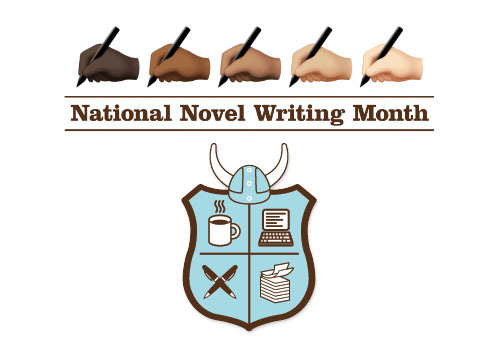
Dear NaNo,
As a creative writing nonprofit, we’re not a political organization. We don’t endorse candidates or support any particular party. In an ideal world, we would focus only on empowering people to write.
Yet we find ourselves in a time where people’s ability to tell their stories—and even to safely exist—is at stake.
NaNoWriMo strives to be a gateway and sanctuary for people’s voices. Our guiding belief is that every person’s story matters, and we celebrate the inclusion of all religions, races, genders, sexualities, and countries of origin. We help people find a safe space to be who they are—creators, storytellers, and world changers.
Because of this core organizational value, we join the many voices standing against the presidential executive order that bans refugees and people from seven Muslim-majority countries from entering the United States.
For over 15 years, we’ve had the privilege of writing alongside a community from over 200 countries, including Iran, Iraq, Libya, Sudan, Syria, and Yemen. We don’t build walls. We strive to dissolve borders through stories, the vital human narratives that expand our worlds.
So while we are not a political organization, we feel moved to take action.In response to the executive order, as well as any future government efforts that threaten people’s basic freedoms, we will:
Celebrate creativity over apathy, diversity over fear, and productivity over despair.Welcome all stories and continue to make NaNoWriMo a safe space for all writers.
Advocate for the transformative power of storytelling to connect people and build a better world.
If you have concrete ideas for how we can work toward these goals (or if you have feedback about anything in this message), please share your thoughts.
Thank you for being part of NaNoWriMo. We are all individuals of different beliefs and backgrounds, but we come together through a shared passion. We pledge to remember that, and to look to our community as a model and inspiration, as we get to the work ahead.
With gratitude and optimism,
Grant Faulkner
Executive Director
Future Actions: We are also concerned about upcoming issues that may affect people’s self-expression, like the President’s desire to eliminate the National Endowment for the Arts (NEA) and the National Endowment for the Humanities (NEH). The NEA is a crucial source of support for many nonprofit writing organizations, and has provided funding for NaNoWriMo in the past. The NEH has awarded $515 million to libraries, many of which provide local writing spaces through our Come Write In program.
If these cuts are proposed, National Novel Writing Month will respond and advocate.
February 8, 2017
Now What? How (Sometimes Unexpected) Resources Can Help You Publish Your Novel

You wrote a novel! Now what? NaNoWriMo’s “Now What?” Months are here—this February, we’ll be helping you guide your novel through the publishing process. Today, author Jeannie Zokan shares a few of the resources that helped her along the path to becoming published:
I found NaNoWriMo in Barnes & Noble one cold and rainy night. I didn’t even know what I was looking for, but when I read the first page of Chris Baty’s No Plot? No Problem! I knew it would guide me to write the novel that kept eluding me. The Existence of Pity was my third go-round with NaNoWriMo, and I wouldn’t be on the published side of the manuscript without a lot of help.
My best resource was NaNoWriMo itself. The website is full of connections, ideas, and support. It’s also where I learned of the Book Doctors. The Essential Guide to Getting Your Book Published is an excellent comprehensive manual, and working with Arielle Eckstut and David H. Sterry over the phone proved to be a turning point for my writing.
Another resource has been my local group of writers. My publisher thought I had my manuscript professionally edited, which is a testament to the thorough and thoughtful editing provided by the critique groups in the West Florida Literary Federation. Local writing groups are filled with writers and readers who love stories and who provide assistance and support, usually in the form of a well-chosen word–or a slash through a redundant one.
“Truly our best resources are our readers, who remind us why we write, and encourage us to keep going.”Writer’s Digest and QueryTracker.net were my main resources when it came time to search for agents and publishers. I sent out three waves of query letters, and at first was met with rejection–and dead silence. Something told me my manuscript could still be improved, so I went through it chapter by chapter with a beta reader: my daughter. I wish I could share this goldmine of a resource with you, but she’s busy being a teenager. Truly our best resources are our readers, who remind us why we write, and encourage us to keep going. I recommend getting beta readers to write notes about what they love about your work. Then read those words every day!
In September of 2015, I sent out queries to a specific group. Query Tracker has a “Query Methods,” column describing how each agent and publisher accepts queries: snail mail, email, and/or an online form. I went through hundreds of names and only queried those with an online form. I had been concerned about the formatting of my emailed query letters, so using their form meant they were receiving my work in a readable and professional format, with no carets down the side, no gaps between paragraphs, and no sentences that scrolled too far to the right.
Once that last set of queries was sent out, I knew I’d gone as far as I could go with The Existence of Pity. If it didn’t get picked up, maybe it was time to try a different manuscript. After all, I’d written seven other November novels.
Six weeks later, I got a call from a publisher. I was in the car with my husband and I only answered my phone because I thought it might be family. Instead, Lynn McNamee from Red Adept Publishing was on the line. We spoke for about forty minutes as Chris and I sat in front of a Walgreens, staring at a blue Tastee Freez shop across the street, taking turns holding the phone between us. The realization that my book was finally going to be published dawned on me over and over again, more amazing each time, and I have a multitude of people, and resources, to thank for my success.

Jeannie Zokan grew up in Colombia, South America. Her love of books led her to study Library Science at Baylor University, then at The George Washington University. She now lives along Florida’s Gulf Coast with her husband and two teenage daughters. Her debut novel, The Existence of Pity, tells the story of Josie, 16, who feels torn between the beliefs of her parents and the need to choose for herself, especially when she realizes a web of lies threatens to destroy her family. Follow Jeannie’s blog, A Writer’s Cup, or find her on Facebook.
Top photo by Flickr user Matthew.
February 6, 2017
A Step-by-Step Guide to Making, Publishing, and Selling Your Audiobook
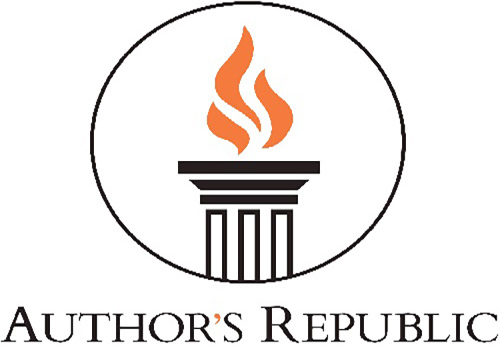
Every year, we’re lucky to have great sponsors for our nonprofit events. Author’s Republic, a NaNoWriMo 2016 sponsor, is an audiobook platform for independent authors and publishers to sell their audiobooks to listeners through 20+ digital audiobook distributors. Today, some of the experts at Author’s Republic share their knowledge of simple and effective tools for publishing your audiobook:
There’s no doubt about it, the audiobooks industry is booming and there are no signs of it slowing down. If you haven’t already, now is the time to jump on the audio train and get your book on the fastest growing market in the industry.
How do I get started?The most challenging part of jumping into a new project is figuring out where to start. Luckily, there are some great options at your disposal to help you create a beautiful audiobook:
1. Use an A-Z service.You may want to consider an A-Z service that will take care of the entire audiobook creation process for you. Now legendary in the audiobook industry, Deyan Audio has to its credit multiple Grammy, Audie, Earphone, and Listen Up Awards. The company works with the largest publishers and has handled all aspects of production, including casting and directing, for thousands of audiobooks. Some other great A-Z companies to checkout include Bee Audio, Spoke Media, and more.
2. DIY: Hire a Narrator.Finding the right voice for your audiobook is critical, and while self-narration is an option (see below), there are some benefits to hiring voice talent. Many professionals who have experience narrating audiobooks have developed a sense of what works (and what doesn’t), allowing them to improve the quality of your recording. Professionals use their artistic abilities to truly bring your script to life, infusing the recording with subtle touches honed through years of experience. Furthermore, voice talent will typically be working from fully-equipped recording studios, resulting in a high-quality audio production. There is no shortage of performers out there to choose from, and services such as Voice.com, Voice123, and VoiceBunny can help you connect with thousands of artists all over the world. For more information on the process of finding and hiring creative talent, head on over here.
3. DIY: Self-Narration.There’s something special about audiobooks read by their authors. Authors understand the tone, direction and overall feel of a book better than anyone. To create the ideal space for recording, try and setup in a carpeted room and add lots of blankets and cushions for padding (check out the home studio one author made out of her closet).You’ll also need a computer or tablet with some recording software. Audacity is a great option, as it’s free and easy to use. You’ll also want to get yourself a high-quality microphone. The built-in one on your device is an option, but for higher sound quality you may want to invest in a better mic. There are many affordable USB mics available that can plug directly into your computer or tablet—one popular option is the Blue Microphones Snowball. You’ll want to check out our full list of tips & tricks for self-narration to get best result possible.
4. I’m ready to sell!You’ve turned your book into an audiobook, congratulations! The next step is to get it out there for the world to enjoy. There are hundreds of audiobook retailers looking to add to their growing library every day, and they want you! Depending on your location, you can upload your audiobook directly to distributors, but for ease of use and the widest distribution available, Author’s Republic has got you covered. Simply upload your completed audiobook and we’ll do the rest. See your audiobook on the most popular platforms like Audible, and Audiobooks.com, as well as global players outside of North America, such as Storytel and Audioteka.
5. #promotepromotepromoteYour audiobook is out there, ready to be heard by millions around the world! But the job’s not done yet: it’s up to you to promote yourself and your audiobook. Word of mouth can be a fantastic tool, but for the most part you’ll need some marketing to help create buzz (and sales) for your audiobook. Work with your retailers and publisher to setup promotions, and don’t forget the power of social media to help spread the word.
You now have a solid tool belt to help create your audiobook, so don’t settle for just a print/ebook edition. Join the thousands of others contributing to the fastest growing market in the industry, and enjoy the ride.
February 5, 2017
I Published My NaNo-Novel: How to Create and Adjust Your Marketing Plan as a Self-Published Author
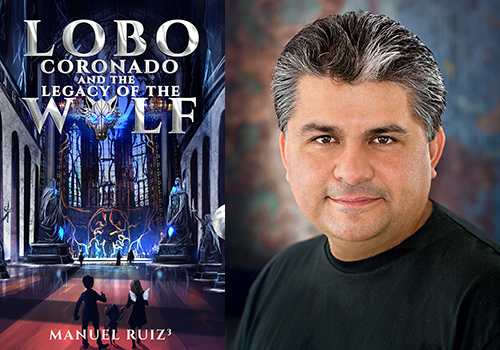
During our “Now What?” Months, we’re talking to Wrimos who’ve self-published their NaNoWriMo projects and asking them about the steps they took to make it happen. Today, Manuel Ruiz , author of the upcoming Lobo Coronado and the Legacy of the Wolf , shares what he’s learned on the rocky road to self-publishing:
I self-published my first novel a little more than a year ago, and my second novel will be out in a few weeks. Prior to that first release, I spent significant time via writing groups and organizations and reading everything I could get my hands on how to self-publish. The two most important things that seemed to be universal (and incur the most cost) were:
1. Find an editor
2. Get a great cover.
My manuscript was already edited so I researched and found a cover designer. Once that was ready, I thought about how I was going to get the word out.
I spent a little time studying and quickly discovered having only one book in middle grade fantasy limited my options (at least, that was my conclusion at the time). I used social media, primarily Facebook, to announce the launch. I also had a website, did a free Kindle giveaway, and even made a good luck voodoo doll I tried to rain money on. I had a good initial reaction to my novel and was soon contacted by Facebook friends who helped arrange a book talk/signing and set me up with a booth at a city festival. The signing was a success, and during the festival, I was interviewed on the radio and a regional television show which led to additional sales and school/event bookings.
I know that I was extremely fortunate to get this kind of exposure without a better marketing plan. I never liked asking friends to buy popcorn for school fundraisers and now I had to start hitting people up to buy my book? Ugh. I didn’t even want to use the voodoo doll for that, but I knew I had to take a different approach for the next book.
“The key thing is to keep learning and adjusting. Every writer wants to sell a gazillion books, but it takes time and research to see what works best.”I spent more time researching and found generous resources in the Indie community such as Chris Fox, Sean Platt, Johnny B. Truant, and others. I used their advice and information to experiment with word sprints and complete my first NaNoWriMo in 2016, where I wrote over 52K words in 14 days. I also learned about targeting audiences through ads and websites and strategies for books that are free vs. on sale.
For my upcoming book, I am going to use a limited $0.99 sale and give away free short stories related to my first book to entice readers to sign up for my website and leave reviews. Why? Ads, announcement sites, and giveaways are all great marketing tools; however, building an e-mail list of readers who love what you write is the key to future success. The more you have to offer, the more subscribers you’ll have. I now have a short-term and long-term strategy that will change and grow as dictated by the number of books I publish, the market, the genre, and experimentation.
The success of my strategies for my second book have yet to be determined, but the key thing is to keep learning and adjusting. Every writer wants to sell a gazillion books, but it takes time and research to see what works best.
I’m a writer and I have stories to tell, and so do you. Just tell your stories. You will need an editor, a great cover, and a marketing plan eventually, but none of that can happen until you have a finished product. Get that first draft done–you have plenty of time to make it better until the day you are ready to publish. You can’t fix what doesn’t exist.
Wishing everyone the best!
Manuel Ruiz is a life-long Texan, born in the town of Alice and raised in nearby Robstown, the birthplace of Texas Hold ’Em. He earned his Bachelor of Science degree in Math/Computer Science from Texas A&M University - Kingsville. Manuel currently lives in Round Rock where he balances his time around his family, his IT job, his PlayStation and giving the characters in his head something interesting to do. Visit his website at
www.manuelruiz3.com
, find him on
Facebook
, or check out his Twitter
@ruizman
. Learn more about his first book,
The Dead Club
, or his latest book,
Lobo Coronado and the Legacy of the Wolf
.
February 1, 2017
I Published My NaNo-Novel: How Some Things Happen When You Least Expect Them

During January of our “Now What?” Months, we’re talking to Wrimos who’ve published their NaNoWriMo projects and asking them how they got there. Today, Katherine Webber, author of Wing Jones , shares her story about the ups and downs of querying multiple manuscripts:
I love everything about NaNoWriMo. I love the community. I love the writing sprints. I love that it forces writers to sit down and get all the amazing stories in their head out on paper.
NaNoWriMo 2014 was my second time participating in NaNoWriMo. I’d done it the first time the year before, and I can still remember that feeling of euphoria when I hit 50K and won NaNo, and I knew I was going to be a NaNoWriMo devotee. My 2013 NaNo-novel wasn’t ready to go out in the world, but it did give me the confidence that I could write 50,000 words in a month.
I had an idea about a girl runner, but that was all I had. I didn’t know who she was or why she was running. I sat down on November 1 and started writing to find out her story. I think something about the fast pace of drafting during NaNo really helped the flow of my story, as I had to write the words almost as fast as my character was running. By the end of the month I had 50K. It was a hot mess of 50K, but a hot mess I could work with.
I followed proper NaNo advice and put it away for December, but I couldn’t stop thinking about it. By the time January came around I couldn’t wait to get back to it and finish the story I’d started. Even though NaNo was over, I kept up my NaNo work ethic to finish and edit the manuscript. I shared it with two of my awesome beta readers to get feedback and make it the best book it could be. While I was editing, I was also querying another manuscript I’d finished earlier in 2014. Even though I was excited about it, I couldn’t shake the feeling that I was even more excited about my new NaNo novel. Querying is hard, and can be discouraging, so it was great to have another new project to work on to distract me.
“I ended up with multiple offers of representation, including an offer from my dream agent, who had, interestingly enough, previously passed on my earlier manuscript.”By the end of March 2015 my new novel, Wing Jones, was ready to go out to agents. By this time I’d heard back from almost all the agents I’d sent the previous manuscript to, so I was ready to move on. But then, in a crazy turn of events, the week after I sent out Wing Jones, I ended up getting an offer of representation on the previous novel! I was thrilled, but by this point, I knew that Wing Jones was a stronger book, and the one I wanted to get representation for. I sent a flurry of emails to all the agents who had Wing Jones, letting them know I had an offer of representation and giving them a chance to counter offer. I ended up with multiple offers of representation, including an offer from my dream agent, who had, interestingly enough, previously passed on my earlier manuscript.
I signed with her in May; we went out on submission in June; and within two weeks, I had offers from nine publishers. When my agent and I told them that the bulk of the first draft had been written in one month, they couldn’t believe it. I ended up with a two book deal from Delacorte/Random House in the US and Walker Books in the UK. Wing Jones came out in the UK on January 5th and will be out in the US on March 14th (titled The Heartbeats of Wing Jones). I wrote the first draft of my second book during NaNoWriMo 2015, so right now I’m in the process of editing that. I started a new project for NaNoWriMo 2016, and while I didn’t “win” because I had to prioritize editing my contracted second book, I still got a good head start on my next YA novel.
The best advice is the simplest to give and the hardest to follow: Make writing a priority. Don’t give up. Keep writing. It doesn’t matter if you are a plotter or a pantser, if you are a sloppy drafter or edit as you go, just finish. And then, after you’ve finished and edited it and made it the very best it can be, start writing the next thing. You can do it.
Katherine Webber is originally from California and currently lives in London with her husband. She has also lived in Hong Kong, Atlanta, and Hawaii. Travel, books, and eating out are her favorite indulgences. She spends far too much time on Twitter so come say hello @kwebberwrites. Her debut novel The Heartbeats of Wing Jones will be published by Delacorte/Random House on March 14th.
January 30, 2017
‘NaNo Without Walls’: How One YWP Teacher Created an Editing Mentorship Program for Her Students
 In addition to the main event every November, NaNoWriMo provides free creative writing resources to educators and young participants around the world through our Young Writers Program. Today, educator Julia Dweck shares the ways she’s adapted NaNoWriMo’s programs to work in her classroom:
In addition to the main event every November, NaNoWriMo provides free creative writing resources to educators and young participants around the world through our Young Writers Program. Today, educator Julia Dweck shares the ways she’s adapted NaNoWriMo’s programs to work in her classroom:Writers aren’t born, they are tended and grown, word by word, line by line, and page by page. Teachers are like gardeners who cultivate the process through shared readings, noting the elements that make stories rich experiences, conferencing, and discussing how stories develop and grow. It’s a role I take very seriously.
More than once, I’ve noted to parents that we are sowing the seeds of our future leaders and caretakers. These individuals will need to communicate through the oral and written word. Stories tap into our imagination and develop thinkers who can empathize with their listeners. That’s the power of writing!
In this, my second year rolling out the NaNoWriMo Young Writer’s Program, my goal is to make changes that will keep the act of writing engaging and fresh for my students–while also manageable for me, as their teacher. The following are some changes I’ve made to the YWP for my own classroom, which may be helpful for other educators thinking about doing NaNo in the classroom:
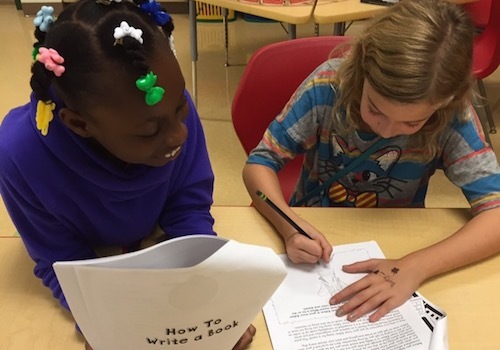 1. Expanding the NaNo Timeline
1. Expanding the NaNo TimelineAs a teacher of gifted students, I work with a unique and diverse population. Contrary to what some may believe, gifted students are not always top writers. A modicum of writing ability may be innate, but developing it requires practice over time. Therefore, expanding the NaNo timeline from a month to a school year seemed a logical choice.
This enhanced timeline allows my students to explore story elements in greater depth before beginning rough drafts. We spend September through December discussing and planning characters, setting, mood, plot outline, and dialogue.
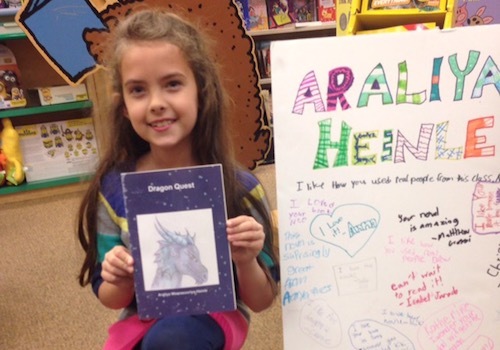 2. Virtual Conferencing
2. Virtual ConferencingAnother modification has been having my students plan, draft, and revise their novels on Google docs, shared with me. No longer does a student claim to have lost or forgotten his or her NaNo packet. Everything is shared and saved on their drives for easy access.
Virtual conferencing expands the window of opportunity to talk one-on-one with each student. As a specialist, my sessions are limited to 40 minutes twice a week. That leaves little time to meet with students individually during each writing session. Retaining students’ writing packets overnight for review impedes their continued progress. Communicating via Google Docs allows me additional time as each student’s virtual guide, extending the interaction beyond classroom hours. I am able to thoughtfully respond to each child’s writing while I am calmly sipping my weekend coffee from the comfort of my kitchen.
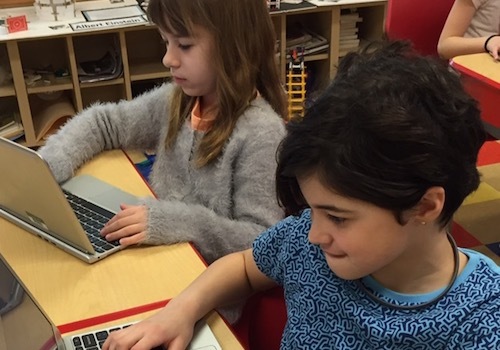 3. Writing Mentors
3. Writing MentorsI began my writing program with 60 gifted students in grades 3, 4, and 5. Each week, my students’ stories grew exponentially, requiring me to spend countless hours on reading, reviewing, and typing feedback in the form of commentary. I believe that leaving feedback is not only instructional, it is motivational and essential. Every writer needs a reader who cares. My problem was a continually growing roster and a limited number of time to read and comment all of their stories. What is a teacher to do?
The answer lies in the larger pool of writers outside the classroom. Thus grew the idea for our “NaNo Without Walls Writing Mentor Program.” Google docs opened a portal to share our stories with talented writers beyond our doors. Through cold-call emails with various directors of highly respected writing programs, I assembled an elite group of “NaNo Mentors”, an organized expert group of advanced placement high school students and outstanding writing students from undergraduate and graduate creative writing programs across the country, including Brown, Rutgers, Barnard, John Hopkins, Columbia, Penn State, and the University of Texas.
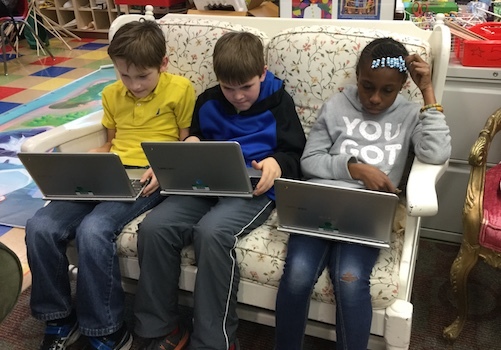
When my students embarked upon their rough drafts in mid-January, we began to pair mentors and students with similar writing interests. I considered each unique characteristic of mentor and writer in determining the best possible matches. One mentor wrote:
“As a kid, I was more into sci-fi/fantasy and now, as a poet, we could very generically say I inhabit a kind of ‘experimental’ space. So [I’m] happy to work with someone who wants to do something a little more 'out there’ (whether that means a more fantastical plot or a more 'surreal’ sort of mood/style).”
NaNo Mentors review their assigned student’s progress on a weekly basis and leave feedback. I am hoping that my students will be motivated by the presence of an expert reader who cares and shares the same enthusiasm for their stories as they do. Not only is it inspiring, it is motivational knowing that your mentor has the same passion and commitment to your story as you do.
Writing is meant to be a social experience. Our NaNo Mentors will enhance the process through active communication and dialogue. Eventually, my students will meet their mentors, either face-to-face or via Skype, solidifying the virtual writing bond they have forged over time.
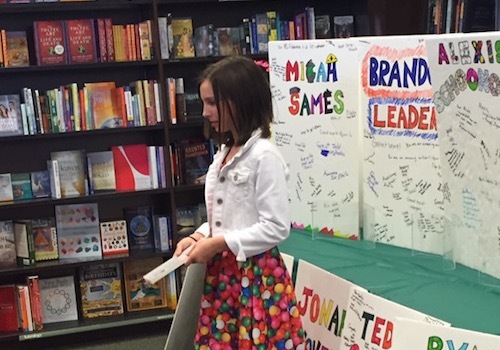
Julia Dweck is the Gifted and Talented teacher at Willow Lane Elementary School in Eastern Pennsylvania. This is her second year doing the NaNoWriMo programs with her students. Follow her students’ noveling progress on Twitter @GiftedTawk.
January 27, 2017
Joining an Editing Community: Sometimes, It Takes a Village

Every year, we’re lucky to have great sponsors for our nonprofit events. Scribophile, a NaNoWriMo 2016 sponsor, is one of the largest independent writing communities online. Today, author Rebel Farris shares how joining Scribophile helped her develop a professional-quality draft:
As a first-time novelist who hadn’t taken an English class in nearly 20 years, finishing NaNoWriMo 2016 with 108k words was quite an accomplishment. Cue the sweaty-palmed, heart-racing nervous breakdown, as I stared down the big E-word: edits. I had no idea where to even begin. I was in panic mode, for a multitude of reasons. The most obvious was that I was sure my grammar was atrocious—but also, I had no clue if the end result was a good story or not.
I knew it needed another set of eyes on it, but finding willing and educated eyes is easier said than done.
After completing NaNoWriMo, I decided to peruse the winner’s offerings and stumbled across Scribophile. My curiosity was piqued: a community of writers that critique each other’s work using a karma point system. Earn points by critiquing; spend points to post your work.
Skeptical, I decided to use the free membership to post my first chapter. Within an hour, I’d received three critiques on my work. It took me all of a day to decide the premium membership was worth it and quickly utilized my NaNo winner’s discount.
Not only was it incredibly encouraging, it was an educational experience. The critiques pointed out grammar mistakes. They also addressed confusing sentence structure and even offered constructive suggestions on how I could fix the errors I had made.
What I quickly learned was that the more I utilized critiquer’s advice and fixed errors before posting more chapters, the more in-depth their critiques became. They started reacting to my work, laughing at the jokes, getting frustrated when the characters made bad decisions, and even saving me from a dreaded continuity error.
“Their belief in me, and their love of my story and characters, gave me the courage to take the next step.”Then the best part: I developed fans. I gained ten critiquing partners who chose to follow my work to the very end. I created a private group with these awesome helpful people and it has become our own community within the Scribophile community.
We critique each other’s work, offer helpful advice, and help work out the kinks in our stories that go beyond the initial critique. But the absolute best benefit by far was the encouragement I received. Their belief in me, and their love of my story and characters, gave me the courage to take the next step.
I started my journey on Scribophile by posting that first chapter on December 4th, and after posting 30 more chapters, my group and I completed edits on my first novel on January 15th. In that time I was also able to write another 30k words towards my second novel, which I plan to have finished by the end of January.
I now have a support system that can’t wait to get their hands on that next book, which makes it so much easier to meet my daily writing goals.
My book is currently in the hands of seven beta readers, who are pleased with the clean, professional-quality draft I was able to provide, allowing them to fully focus on the story, rather than errors and mistakes. I also have a professional editor lined up, a book cover design and photography shoot scheduled, and a tentative release date with a marketing firm. I don’t know if I would have taken that chance to believe in myself and invest in publishing my book had I not met the wonderful writers at Scribophile.

Rebel Farris writes New Adult Romantic Suspense and is the author of the upcoming Derby Girls series. A graduate of University of Houston, the former Roller Derby athlete lives in Austin, TX with her three kids and canine sidekick, Spike. She reads insatiably, collects Japanese stationery, and spends the rest of her free time outdoors, hiking and kayaking. Her debut novel, Falling Small, began life as a 2016 NaNo novel and will be published in late April 2017. Visit her website at rebelfarris.com; catch up with her on Facebook; or follow her on Twitter @Rebel_Farris.
January 25, 2017
5 Quotes on Editing That Will Always Be Relevant
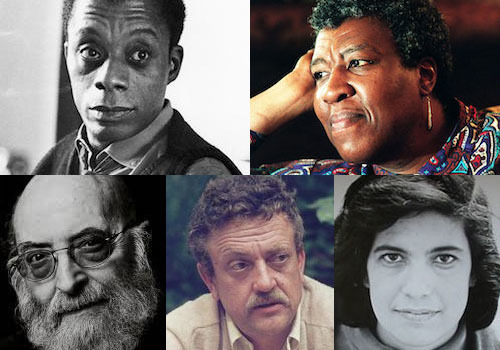
During January of our “Now What?” Months, we’re here to give you some inspiration and resources as you dive into those daunting edits on your novel. While we usually share lots of advice with you from contemporary authors, sometimes it’s nice to take a look back through history and realize that editing problems have always been the same:
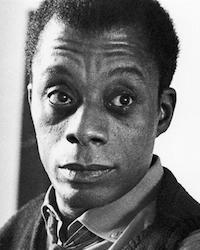 1. James Baldwin
1. James Baldwin“Rewriting [is] very painful. You know it’s finished when you can’t do anything more to it, though it’s never exactly the way you want it… The hardest thing in the world is simplicity. And the most fearful thing, too. You have to strip yourself of all your disguises, some of which you didn’t know you had. You want to write a sentence as clean as a bone. That is the goal.”
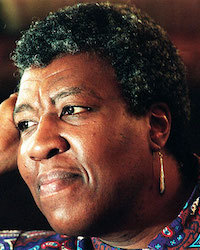 2. Octavia Butler
2. Octavia Butler“You don’t start out writing good stuff. You start out writing crap and thinking it’s good stuff, and then gradually you get better at it. That’s why I say one of the most valuable traits is persistence.”
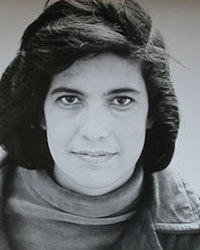 3. Susan Sontag
3. Susan Sontag“I don’t write easily or rapidly. My first draft usually has only a few elements worth keeping. I have to find what those are and build from them and throw out what doesn’t work, or what simply is not alive.”
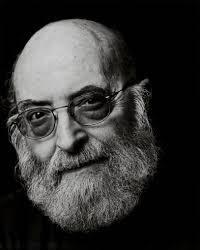 4. Chaim Potok
4. Chaim Potok“I think the hardest part of writing is revising. And by that I mean the following: A novelist has to create the piece of marble and then chip away to find the figure in it.”
 5. Kurt Vonnegut
5. Kurt Vonnegut“Your eloquence should be the servant of the ideas in your head. Your rule might be this: If a sentence, no matter how excellent, does not illuminate your subject in some new and useful way, scratch it out.”
January 23, 2017
7 Tips to Help You Self-Edit Your Novel

You wrote a novel! Now what? NaNoWriMo’s “Now What?” Months are here—this January and February, we’ll be helping you guide your novel through the revision and publishing process. Today, author Derek Murphy shares a few of his favorite editing tips to help you strengthen your writing:
Before you put your NaNoWriMo novel out into the world, you’re going to need to clean it up. Probably, a lot. Typos, poor grammar, and spelling mistakes are inexcusable for writers, and yet very common. Everybody makes mistakes.
A great editor will always make things better, but they won’t change or rewrite the story for you. They may identify crucial plot holes or character development problems, but they won’t fix them.
Even if you can’t afford a professional editor, it almost never hurts to have another pair of eyes look over your manuscript. But before you hand your writing to anyone else to read, you should clean it up as best you can, and know that readers will forgive a lot if you can hold their interest with a great story. The following seven tips relate to trends I’ve noticed among new writers. Use them like a checklist and you’ll be able to strengthen your writing.
1. Build conflict and sympathy first.Your book needs conflict, and your main character has to be sympathetic from the beginning. We need to root for, pity, and bond with the main character, and hate and loathe the opposition. There must be a villain, or a source of conflict, or a foil – somebody who for some reason makes the protagonist feel bad. The protagonist should doubt him/herself, so that through the story they can gain self-confidence and existential security. No matter how cool the action scenes are, if we don’t know who to root for, if we don’t feel an emotional connection to the outcome, we just don’t care. Before I know which characters are good or evil, when they’re all strangers to me, I wouldn’t care if any of them got hit by a bus–which means I’m not invested in your story. Before you can blow things up and have epic shoot-outs, readers need to know, love, and care about your protagonist.
2. Start with the action.Almost all scenes/chapters need to start in the middle of the action. Cut out all the lead up stuff. Cut out the explanation, back story, exposition and description of the scene. Start in the middle of a tense dialogue. Start with an attention-hooking line. Start with close-up, focused, zoom-in of drops of blood, sweat, and tears. Hook attention first–then back up, fill in the details, slow down, and set up the next major conflict.
3. Believable characters don’t flip-flop between extreme emotions.Usually, people laugh when they’re happy. They’re short-tempered and snarky when they are angry. But they rarely “sob hysterically”, “shriek uncontrollably”, or “shake visibly.” People don’t typically let their emotions run wild–especially around a big group of other people. And they don’t often flip-flop between intensely elated and deathly depressed at every minor catastrophe. In fact, people usually don’t react at all when bad things happen–they are in shock. The emotions sink in when they have time to process their grief. So check how often your main character (or any characters) cry, sob, scream, shriek, etc. Experiment with how to portray intense emotional reactions in a subtler way.
4. Know your grammar.It’s the easy stuff we tend to miss: It’s/Its, There/Their/They’re, etc. Even if we can spell big words correctly backwards, you’re going to mess the simple stuff up. Use the search/find feature to search for these kinds of simple homophones one by one and check them all. If you notice something else you screwed up, search for it–you probably did it more than once. Also, we tend to have ‘bad batches’–so if you find any errors, super-edit that section, because there are likely to be more errors nearby.
5. Watch out for adverbs.Adverbs are bad. They are lazy writing. Anytime you express what someone did and how they did it by adding an -ly (”said excitedly”, “left resolvedly”, “prayed devoutly”, etc.) you’re missing the chance to write well and picking something easy. A lot of these phrases will be meaningless (like “laughed happily”). Or they will be confusing. So use your search/find button for “ly” and track them all down. Does it need to be there? Is there another way you can show how they did something without using an adverb?
“Said excitedly” = “said, a grin spreading at the corners of his mouth and his body quivering with expectation.”
“Left resolvedly” = “stamped out of the room, slamming the door behind him.”
Seriously: search every one and try to get rid of them all.
Edit: Ok, not all. Some adverbs are acceptable. But get rid of the really bad ones that don’t mean anything. Be aware of the tendency to use them poorly, so that when you do decide to use them, you use them well and they improve your writing.
6. Be sparing with exclamations.Now use the find/replace feature to search for “!” and “?!”. This ties into the extreme emotion flip-flopping: most people in everyday life don’t shout or exclaim at every unexpected thing. That means you hardly ever need to use exclamation points. I’ve seen a lot of indie authors have characters saying things like “How dare you!!!” or “Are you crazy?!?!” Lots of punctuation is no substitute for good writing. Not only is it unnecessary, it’s often used to mask over weak dialogue–so searching for your “!” can indicate poor dialogue that you need to strengthen.
7. Make the narrator’s language fit the scene.Unless you’re writing a first-person narrative, the narrator should be invisible. So when you use big, strange, fancy, or unusual words, it interrupts the action and draws attention to the narrator. This especially happens with repetition: a novel I read recently used “purchase” in the sense of “to gain traction.” The first time I thought it was a bit odd. By the third time, it had really distracted me from the narrative of the story. You are likely to have favorite words that you like to use, but when you pick a fancy word instead of a common word, it will stand out. Characters themselves can use them in dialogue, but you don’t need to use them.
A cool online tool you can use to check the frequency of all the words you used in your book is Textalyzer.net. Just paste all your text there and look at the most common words, to see if you have any bad habits you should break.
Read the full article and 26 more self-editing tips on www.creativindie.com.

Derek Murphy has a PhD in Literature, and was a book editor before specializing in making books beautiful. He’s been self-publishing since 2004, and helps indie authors sell more books through a variety of tools, resources and platforms.
Top photo by Flickr user Caleb Roenigk.
January 20, 2017
Now What? How an Editor Can Catch the Things You Miss

You wrote a novel! Now what? NaNoWriMo’s “Now What?” Months are here—this January and February, we’ll be helping you guide your novel through the revision and publishing process. Today, author and NaNoWriMo participant Cass R. Morris shares a peek into her research and editing process:
When we think about editing, we think about the words. We think about cutting scenes, adding them, rearranging them. We might even think about “big picture” edits that change a major plot point or eliminate a character. But what about the world that all those smaller components take place in?
By the time From Unseen Fire sold, I had been living in its world for almost four years. An alternate-history version of Rome, but with magic. I knew its history, and where it diverged from our universe’s. I had maps galore. I’d gone through stacks of books about the pattern of an average Roman’s day. I had clearly defined how my system of magic worked. I would not have thought I needed to spend even more time world-building.
But I did.
My editor’s eyes caught what I hadn’t–or perhaps it’s more that her brain asked questions I had only half-answered.
A lot of them were economic – something I’ll admit I tend to hand-wave, much though I shouldn’t – but the one that ended up being the most fun to dig into was demographic. “Just how many mages are there in Aven?”
Well. I had a vague idea, but when she asked the question, I realized (as someone who’s always been bothered by the relative size of Hogwarts to the wizarding population of Britain) that I had to come up with a definite answer.
For a start, that meant figuring out the total population of the city. Easy enough–history gives me some guidelines to go on. Augustus’s 14CE census put the population of Rome at about 750,000; since my Aven is set some 70 years earlier earlier, has expanded more slowly, and has recently been through some rough times, I set my total at about 350,000.
Then I had to think about what proportion of the population would be magically gifted. They perceive it as a blessing bestowed by the gods, and it’s unusual, but not super-rare. There are enough that the non-mages have always been worried about their potential power accumulation and have written the city’s laws to keep them out of higher office, and–thinking back to my economics–there are enough mages who make a career out of their talents to participate in the economy, but not to overwhelm it. After playing around with some numbers, a birth rate of about one in a thousand seemed reasonable. That gives me about 350 mages in the City of Aven, distributed so that there are about 35 in each of the major districts, and thus, probably at least one or two per neighborhood.
And then I went even deeper.
I mean, if I knew how many there are, I should know who they are, right? How many are patrician versus plebeian? How many have a lot of natural talent versus just a touch, and how many have good magical education? What’s the age distribution? What’s the distribution of the various Elements, since some are more common than others? And, perhaps most importantly, what do they do? I took inspiration from research and Roman poetry, applying the system of magic I’d developed to the demographic and economic patterns of my world. Here’s a peek into the world of Aven, as seen through its magical community:
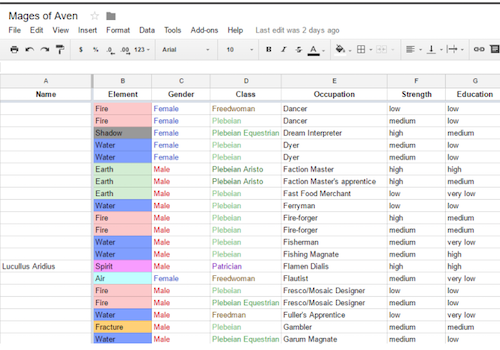
Not everyone’s world-building details will look the same, but they’re important to consider, no matter what kind of story you’re telling. If it’s historical, dig into your facts. If it’s fantasy or sci-fi, apply real-world dynamics to it. If it’s contemporary, be sure to think about the amazing spectrum of the world we live in. Having these details in your head and being able to include them in the background of your story results in a richer and more satisfying world for your readers to visit.

Cass Morris is, by day, a Shakespeare educator who develops classroom resources, writes teaching guides, and leads workshops and seminars. A graduate of Mary Baldwin University and the College of William and Mary, she lives in western Virginia with two royal felines, Princess and Ptolemy. She reads voraciously, wears corsets voluntarily, and will beat you at MarioKart. Her debut novel, From Unseen Fire , began life as a 2011 Nano novel and will be released through DAW Books on September 5th, 2017. Visit her website at cassmorriswrites.com; catch up with her on Goodreads ; or follow her on Twitter @CassRMorris.
Top photo by Flickr user Amber Case.
Chris Baty's Blog
- Chris Baty's profile
- 63 followers



